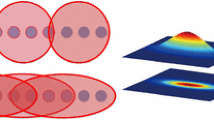Abstract
Existing techniques for animation of object fracture are based on an assumption that the object materials are homogeneous while most real world materials are heterogeneous. In this paper, we propose to use movable cellular automata (MCA) to simulate fracture phenomena on heterogeneous objects. The method is based on the discrete representation and inherits the advantages from both classical cellular automaton and discrete element methods. In our approach, the object is represented as discrete spherical particles, named movable cellular automata. MCA is used to simulate the material and physical properties so as to determine when and where the fracture occurs. To achieve real-time performance, we accelerate the complex computation of automata’s physical properties in MCA simulation using CUDA on a GPU. The simulation results are directly sent to vertex buffer object (VBO) for rendering to avoid the costly communication between CPU and GPU. The experimental results show the effectiveness of our method.









Similar content being viewed by others
Explore related subjects
Discover the latest articles, news and stories from top researchers in related subjects.References
Imagire, T., Johan, H., Nishita, T.: A fast method for simulating destruction and the generated dust and debris. Vis. Comput. 25, 719–727 (2009)
Terzopoulos, D., Witkin, A.: Physically based models with rigid and deformable components. IEEE Comput. Graph. Appl. 8, 41–51 (1988)
Terzopoulos, D., Fleischer, K.: Modeling inelastic deformation: viscolelasticity, plasticity, fracture. In: Proceedings of the 15th Annual Conference on Computer Graphics and Interactive Techniques, pp. 269–278 (1988)
Norton, A., Turk, G., Bacon, B., Gerth, J., Sweeney, P.: Animation of fracture by physical modeling. Vis. Comput. 7, 210–219 (1991)
O’Brien, J.F., Hodgins, J.K.: Graphical modeling and animation of brittle fracture. In: Proceedings of the 26th Annual Conference on Computer Graphics and Interactive Techniques, pp. 137–146 (1999)
Parker, E.G., O’Brien, J.F.: Real-time deformation and fracture in a game environment. In: Proceedings of the 2009 ACM SIGGRAPH/Eurographics Symposium on Computer Animation, New Orleans, Louisiana, pp. 165–175 (2009)
Bao, Z., Hong, J., Teran, J., Fedkiw, R.: Fracturing rigid materials. IEEE Trans. Vis. Comput. Graph. 13, 370–378 (2007)
Su, J., Schroeder, C., Fedkiw, R.: Energy stability and fracture for frame rate rigid body simulations. In: Proceedings of the 2009 ACM SIGGRAPH/Eurographics Symposium on Computer Animation, New Orleans, Louisiana, pp. 155–164 (2009)
Desbrun, M., Cani-Gascue, M.: Animating soft substances with implicit surfaces. In: Proceedings of the 22nd Annual Conference on Computer Graphics and Interactive Techniques, pp. 287–290 (1995)
Muller, M., Keiser, R., Nealen, A., Pauly, M., Gross, M., Alexa, M.: Point based animation of elastic, plastic and melting objects. In: Proceedings of the 2004 ACM SIGGRAPH/Eurographics Symposium on Computer Animation, Grenoble, France, pp. 141–151 (2004)
Muller, M., Heidelberger, B., Teschner, M., Gross, M.: Meshless deformations based on shape matching. In: Proceedings of the ACM SIGGRAPH 2005 Papers, Los Angeles, California, pp. 471–478 (2005)
Pauly, M., Keiser, R., Adams, B., Dutre, P., Gross, M., Guibas, L.J.: Meshless animation of fracturing solids. In: Proceedings of the ACM SIGGRAPH 2005 Papers, Los Angeles, California, pp. 957–964 (2005)
Guo, X., Qin, H.: Real-time meshless deformation. Comput. Animat. Virtual Worlds 16, 189–200 (2005)
Bell, N., Yu, Y., Mucha, P.J.: Particle-based simulation of granular materials. In: Proceedings of the 2005 ACM SIGGRAPH/Eurographics Symposium on Computer Animation, Los Angeles, California, pp. 77–86 (2005)
Liu, N., He, X., Li, S., Wang, G.: Meshless simulation of brittle fracture. Comput. Animat. Virtual Worlds 22, 115–124 (2011)
Guo, X., Li, X., Bao, Y., Gu, X., Qin, H.: Meshless thin-shell simulation based on global conformal parameterization. IEEE Trans. Vis. Comput. Graph. 12(3), 375–385 (2006)
Psakhie, S.G., Horie, Y., Korostelev, S.Y., Smolin, A.Y., Dmitriev, A.I., Shilko, E.V., Alekseev, S.V.: Method of movable cellular automata as a tool for simulation within the framework of mesomechanics. Russ. Phys. J. 38, 1157–1168 (1995)
Psakhie, S.G., Korostelev, S.Y., Smolin, A.Y., Dmitriev, A.I., Shilko, E.V., Moiseyenko, D.D., et al.: Movable cellular automata method as a tool for physical mesomechanics of materials. Phys. Mesomech. 1(1), 89–101 (1998)
Psakhie, S.G., Moiseyenko, D.D., Smolin, A.Y., Shilko, E.V., Dmitriev, A.I., Korostelev, S.Y., et al.: The features of fracture of heterogeneous materials and frame structures. Potentialities of mca design. Comput. Mater. Sci. 16(1–4), 333–343 (1999)
Psakhie, S.G., Zavshekand, S., Jezershek, J., Shilko, E.V., Dmitriev, A.I., Smolin, A.Y., et al.: Computer-aided examination and forecast of strength properties of heterogeneous coal-beds. Comput. Mater. Sci. 19(1–4), 69–76 (2000)
Psakhie, S.G., Horie, Y., Ostermeyer, G.P., Korostelev, S.Y., Smolin, A.Y., Shilko, E.V., et al.: Movable cellular automata method for simulating materials with mesostructure. Theor. Appl. Fract. Mech. 37(1–3), 311–334 (2001)
Chen, K.: MCA method and the study of penetration of projectile into concrete target. Ph.D. Thesis, Nanjing University of Science and Technology, Nanjing (December 2005)
Green, S.: CUDA particles. White paper (November 2007)
Georgii, J., Westermann, R.: Mass-spring systems on the gpu. Simul. Model. Pract. Theory 13(8), 693–702 (2005)
Liu, W., Schmidt, B., Voss, G., Mller-Wittig, W.: Accelerating molecular dynamics simulations using graphics processing units with cuda. Comput. Phys. Commun. 179(9), 634–641 (2008)
Acknowledgements
We first thank the anonymous reviewers for their careful and valuable comments. We are grateful to Aiping Wang and Kai Xu from NUDT for fruitful discussions. This work is supported by the National Basic Research Program (No. 2009CB723803) and the National Science Foundation Program (No. 60873120) of China.
Author information
Authors and Affiliations
Corresponding author
Rights and permissions
About this article
Cite this article
Ning, J., Xu, H., Wu, B. et al. Modeling and animation of fracture of heterogeneous materials based on CUDA. Vis Comput 29, 265–275 (2013). https://doi.org/10.1007/s00371-012-0765-1
Published:
Issue Date:
DOI: https://doi.org/10.1007/s00371-012-0765-1




